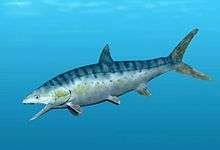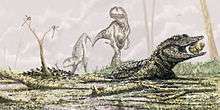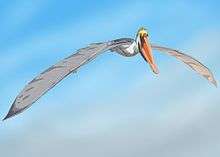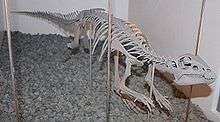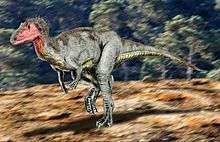Wessex Formation
| Wessex Formation Stratigraphic range: Berriasian–Barremian, 145–125 Ma | |
|---|---|
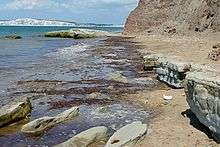 The Undercliff near Shalcombe, Isle of Wight | |
| Type | Geological formation |
| Unit of | Wealden Group |
| Sub-units |
|
| Underlies | Vectis Formation |
| Overlies | Durlston Formation |
| Thickness | up to 1000 m near Swanage |
| Lithology | |
| Primary | mudstone |
| Other | sandstone, ironstone & conglomerate |
| Location | |
| Region | Southern England |
| Country |
|
| Extent | Dorset, Isle of Wight, offshore Wessex Basin |
The Wessex Formation is a fossil-rich English geological formation that dates from the Berriasian to Barremian stages (about 145–125 million years ago) of the Early Cretaceous. It forms part of the Wealden Group and underlies the younger Vectis Formation and overlies the Durlston Formation.[1] The dominant lithology of this unit is mudstone with some interbedded sandstones.
Fauna
Invertebrates
Invertebrates are commonly preserved in the Wessex Formation. Freshwater bivalves can be found including unionoids such as Margaritifera, Nippononaia, and Unio. These bivalves are helpful in reconstructing what the freshwater paleoenvironment may have been like during the formation's deposition. Specimens of Viviparus, a genus of freshwater snail, have also been found. While compression fossils of insects are found in the overlying Vectis Formation, all insect fossils in the Wessex formation are found as inclusions in amber. Amber can be found present as a rare component in other plant debris beds in the Wessex formation both on the Isle of Wight and the Isle of Purbeck, however the only significant concentration and where all of the inclusions have been found is a lag channel in the L6 plant debris horizon just south-east of Chilton Chine. Only two species from the amber have been formally described, Cretamygale chasei a mygalomorph spider, and Dungeyella gavini a chironomid midge.[2] Most of the other taxa in the table come from mentions in the paper describing the latter. However several images of some of the undescribed taxa have been released from various sources, including multiple chironomids, a therevid dipteran, and dryinid hymenopteran[3]
Color key
|
Notes Uncertain or tentative taxa are in small text; |
| Invertebrates of the Wessex Formation | ||||||
|---|---|---|---|---|---|---|
| Genus | Species | Location | Stratigraphic Position | Abundance | Note | Images |
|
C. chasei[4] |
Chilton Chine | L6 Plant debris bed | Single specimen | Mygalomorph spider, has been described from a specimen found in amber. | See article | |
| Dungeyella | D. gavini[5] | Chilton Chine | L6 Plant debris bed | Single specimen | a tiny buchonomyiine/podonomian Chironomid | See article |
| Chironomidae |
Indeterminate |
Chilton Chine | L6 Plant debris bed | 44% of all arthropod inclusions | Uncertain how many taxa represented, likely at least two. at least one is a tanypodian with a wingspan twice that of Dungeyella | |
| Therevidae | Indeterminate | Chilton Chine | L6 Plant debris bed | At least one specimen | At least one specimen figured |  |
| Diptera | Indeterminate | Chilton Chine | L6 Plant debris bed | Multiple specimens | Uncertain how many taxa represented | |
| Dryinidae | Indeterminate | Chilton Chine | L6 Plant debris bed | At least one specimen | At least one specimen figured, presumably male due to presence of wings | 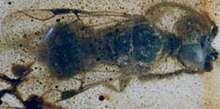 |
| Hymenoptera |
Indeterminate |
Chilton Chine | L6 Plant debris bed | Multiple specimens | Uncertain how many taxa represented | |
| Blattodea |
Indeterminate |
Chilton Chine | L6 Plant debris bed | Single specimen | ||
| Coleoptera |
Indeterminate |
Chilton Chine | L6 Plant debris bed | Single specimen | ||
| Curculionoidea? |
Indeterminate |
Represented by a boring in a gymnospermous seed.[6] |
||||
Cartilaginous fishes
| Cartilaginous fishes of the Wessex Formation | ||||||
|---|---|---|---|---|---|---|
| Genus | Species | Location | Stratigraphic Position | Abundance | Note | Images |
|
H. basanus |
Ergetenodus? |
| ||||
|
Indeterminate 1 |
Yaverland bed 38, L9 |
|||||
|
Indeterminate 2 |
Yaverland bed 38, L9 |
|||||
|
Indeterminate 3 |
Yaverland bed 38, L9 |
|||||
|
Lonchiodon |
L. breve |
Yaverland bed 38 |
||||
|
L. striatum |
Yaverland bed 38, L9 |
51.43% of total Chondrichthyan taxa in L9 |
||||
|
Indeterminate 1 |
Yaverland bed 38, L9 |
|||||
|
Indeterminate 2 |
Yaverland bed 38, L9 |
35.86% of total Chondrichthyan taxa in Yaverland bed 38 |
||||
|
Indeterminate 3 |
Yaverland bed 38, L9 |
|||||
|
Hylaeobatis |
H. problematica |
|||||
|
Palaeoscyllium |
Indeterminate |
|||||
|
Parvodus |
P. heterodon |
|||||
|
Indeterminate |
||||||
|
Vectiselachos |
V. ornatus |
|||||
Ray-finned fish
| Ray-finned fishes of the Wessex Formation | ||||||
|---|---|---|---|---|---|---|
| Genus | Species | Location | Stratigraphic Position | Abundance | Notes | Images |
|
Indeterminate |
||||||
|
Indeterminate |
| |||||
|
Indeterminate |
||||||
|
Indeterminate |
||||||
|
Indeterminate |
||||||
|
Indeterminate |
||||||
Lissamphibians
| Amphibians of the Wessex Formation | ||||||
|---|---|---|---|---|---|---|
| Genus | Species | Location | Stratigraphic Position | Abundance | Notes | Images |
| Wesserpeton[7] | W.evansae | L2 and Yaverland 38 | albanerpetontid amphibian | |||
|
Indeterminate |
Multiple | 1: Yaverland 38 2: L2 and Yaverland 38 3: L2 and Yaverland 38 4: Yaverland 38 5: Yaverland 38 | At least 5 distinct taxa distinguished by characters in their ilium | |||
| Urodela | Indeterminate | Multiple | 1: L2, L14 and Yaverland 33 and 38 2: L9 and Yaverland 38 3: unnamed bed in Compton bay and Yaverland 38 | At least 3 distinct taxa distinguished by their atlas vertebrae | ||
Squamates
| Squamates of the Wessex Formation | ||||||
|---|---|---|---|---|---|---|
| Genus | Species | Location | Stratigraphic Position | Abundance | Notes | Images |
| Meyasaurus | Indeterminate | Yaverland | Yaverland bed 38 | Teeth and a partial lower jaw | Genus also known from Spain | |
| Anguimorpha[8] |
indeterminate |
Multiple plant debris beds | 1st taxon L14 and L2, 2nd L2 and Yaverland bed 38, 3rd Yaverland bed 38 | At least 3 distinct taxa represented by isolated teeth, maxilla and lower jaw fragments | ||
| Scincomorpha[8] |
indeterminate |
Multiple plant debris beds | 1: L14 and Yaverland 38 2: Yaverland 38, 3: L2 and Yaverland 38 4,5: Yaverland bed 38 6:L2, L14 and Yaverland 38 7,8,9: Yaverland 38 10: L2, L14 and Yaverland 38 | At least 10 distinct taxa represented by isolated teeth, maxilla and lower jaw fragments | ||
Turtles
| Turtles of the Wessex Formation | ||||||
|---|---|---|---|---|---|---|
| Genus | Species | Location | Stratigraphic Position | Material | Notes | Images |
|
H. nopcsai |
Shell and skull material |
| ||||
|
Indeterminate |
Shell fragments |
Housed at the dinosaur farm museum |
||||
|
Indeterminate |
Shell |
Housed at the dinosaur isle museum |
||||
| Pleurosternon | Indeterminate | |||||
|
Brodiechelys |
B. brodiei |
|||||
Crurotarsans
| Crurotarsans of the Wessex Formation | ||||||
|---|---|---|---|---|---|---|
| Genus | Species | Location | Stratigraphic Position | Abundance | Notes | Images |
|
A. hooleyi |
Disputed, either uppermost Wessex or lowermost Vectis |
| ||||
| A. epikrator[10] | Hanover Point | Mostly complete skull and partial dentaries and associated postcranial material | ||||
| Bernissartia | Indeterminate | 40 Isolated teeth | ||||
|
H. willetti |
||||||
|
K. aprosdokiti[11] |
| |||||
|
Indeterminate |
||||||
| Vectisuchus | V. leptognathus | Barnes High | Just below base of Vectis formation | "Partial semi-articulated skeleton" | ||
Plesiosaurs
| Plesiosaurs of the Wessex Formation | ||||||
|---|---|---|---|---|---|---|
| Genus | Species | Location | Stratigraphic Position | Abundance | Notes | Images |
|
Indeterminate |
Compton Bay |
Vertebra |
||||
|
Indeterminate |
Tie pits, atherfield |
Propodial |
Leptocleididae? |
|||
Mammals
| Mammals of the Wessex Formation | ||||||
|---|---|---|---|---|---|---|
| Genus | Species | Location | Stratigraphic Position | Material | Notes | Images |
|
E.clemensi[13] |
Multiple debris beds | L9, Yaverland bed 38 and CL3 |
Teeth |
|||
| ?Gobiconodon | Indeterminate | Yaverland | Yaverland bed 38 | Teeth | ||
|
L.valdensis |
Teeth |
|||||
|
Y.gassoni |
Multiple debris beds | Mandible from Yaverland bed 38, isolated teeth from L2, L9 and L14 |
Mandible Fragment and isolated teeth |
| ||
|
Indeterminate |
Multiple debris beds | Yaverland bed 38 and L9 | two lower molars, likely belonging to the same taxon, distinct from other dryolestid teeth so likely to be a new genus and species. | |||
| Eutriconodonta | Indeterminate | Yaverland | Yaverland bed 38 | lower left molariform | ||
|
Indeterminate |
Premolars |
Eutheria? |
||||
Pterosaurs
| Pterosaurs of the Wessex Formation | ||||||
|---|---|---|---|---|---|---|
| Genus | Species | Location | Stratigraphic Position | Material | Notes | Images |
|
C. trimicrodon |
Skull and rostrum fragments |
An ornithocheirid | ||||
|
I. latidens |
Partial skeleton and skull, and referred mandible fragment |
An istiodactylid |
| |||
|
Indeterminate |
Found throughout the sub basin |
Teeth |
Distinct from I.latidens |
|||
|
Indeterminate |
Rostrum fragment |
An ornithocheirid |
| |||
|
Indeterminate |
Humerus |
|||||
|
Indeterminate |
Tooth, potentially a gnathosaurine |
|||||
Dinosaurs
Ornithischians
| Ornithischians reported from the Wessex Formation | |||||||
|---|---|---|---|---|---|---|---|
| Genus | Species | Synonyms | Location | Stratigraphic Position | Material | Notes | Images |
|
H. foxii |
Hypsilophodon bed | Many partial skeletons |
| ||||
|
I. bernissartensis |
Specimens classified as Iguanodon seelyi are referable to this species |
| |||||
|
M. atherfieldensis |
Dollodon bampingi, Proplanicoxa?[15] |
| |||||
|
P. foxii |
| ||||||
|
Indeterminate |
Distinct from P.foxii.[16] |
||||||
|
V. canaliculatus |
Multiple partial skeletons | A dryosaurid |
| ||||
Sauropods
| Sauropods reported from the Wessex Formation | ||||||
|---|---|---|---|---|---|---|
| Genus | Species | Location | Stratigraphic Position | Material | Notes | Images |
|
C. gigas |
"Several cervical vertebrae."[17] |
|||||
|
E. foxi |
"Dorsal vertebra."[17] |
Perhaps a Somphospondylan?[18] | ||||
|
I. valdensis |
"Several caudal vertebrae."[17] |
|||||
|
O. armatus |
"Tooth."[19] |
|||||
|
O. eucamerotus |
"Ischia and pubis."[17] , regarded as an "undiagnostic titanosauriform of uncertain affinities." |
|||||
|
O. hulkei |
One dorsal vertebra.[20] |
|||||
| Undescribed Sauropod | Indeterminate | "Partial postcranial skeleton, including presacral vertebrae, anterior caudal vertebrae, girdle and limb elements" | Currently in private collection and unavailable to researchers. Known informally as "the Barnes High sauropod" | |||
| Sauropoda | Indeterminate | One cervical vertebra and possible associated centrum | Represents a large animal 20 metres or greater in length. Known informally as "Angloposeidon". Perhaps a Somphospondylan? | |||
|
Indeterminate |
Scapula, Vertebra, and Isolated teeth |
Similar in proportions to Demandasaurus |
||||
|
Indeterminate |
Two isolated large middle caudal vertebra, one isolated large cervical vertebra |
|||||
Theropods
| Theropods reported from the Wessex Formation | ||||||
|---|---|---|---|---|---|---|
| Genus | Species | Location | Stratigraphic Position | Material | Notes | Images |
|
Indeterminate |
Isolated teeth |
|||||
|
A. pusillus |
"Sacrum and pubes."[21] |
| ||||
|
Indeterminate |
Isolated teeth, manus bones, vertebrae and skull material |
A spinosaurid possibly synonymous with Suchosaurus cultridens |
| |||
|
C. foxi |
"Vertebrae."[22] |
A compsognathid |
||||
|
C. oweni |
"Vertebrae."[22] |
A possible oviraptorosaur |
||||
|
E. lengi |
"Partial skull and skeleton."[23] |
|||||
|
N. salerii |
"Partial skull and skeleton."[24] |
| ||||
|
O. cluniculus |
A dubious species of dromaeosaurid, once misidentified as a pterosaur |
|||||
|
Indeterminate |
Teeth |
Dubious, uncertain referral on the genus level |
||||
| Tetanurae | Indeterminate | Chilton Chine | Partial pubes and femur[25] | Distinct from Neovenator and Baryonyx. Currently in private collection. | ||
|
T. daviesi |
"Cervical vertebrae."[26] |
A coelurosaur of uncertain classification, possibly an Elaphrosaur. Previously called Thecospondylus, a preoccupied name |
||||
| Undescribed Coelurosaur | Indeterminate | Partial associated skeleton | Apparently small. In private collection and undescribed. | |||
|
Indeterminate |
Isolated teeth |
May belong to a Proceratosaur[27] |
||||
|
Y. bitholus |
Yaverland | "partial skull roof comprising both frontals and parts of the right postorbital and left orbitosphenoid" 2nd specimen known but what elements are represented is not widely published as of 2018 |
A maniraptoran of uncertain classification, originally identified as an ornithischian |
|||
Flora
Spermatophytes
| Spermatophytes reported from the Wessex Formation | ||||||
|---|---|---|---|---|---|---|
| Genus | Species | Location | Stratigraphic Position | Material | Notes | Images |
|
Indeterminate |
Stem fragment (IWCMS.2010.7) |
|||||
|
Indeterminate |
Dubious referral |
|||||
|
Indeterminate |
||||||
|
Pseudofrenelopsis |
P. parceramosa |
Member of Cheirolepidiaceae. Incredibly abundant, sometimes found as entire segments of the trunk |
||||
| Brachyphyllum | B. obesum | |||||
| Pityites | P. solmsii | |||||
| Bennettitales | ||||||
Pteridophytes
| Pteridophytes reported from the Wessex Formation | ||||||
|---|---|---|---|---|---|---|
| Genus | Species | Location | Stratigraphic Position | Material | Notes | Images |
|
Indeterminate |
||||||
|
Indeterminate |
||||||
|
W. reticulata |
Multiple specimens |
|||||
See also
References
- ↑ "Wessex Formation". The BGS Lexicon of Named Rock Units. British Geological Survey.
- ↑ Jarzembowski, E.; Azar, D.; Nel, A. (2009-04-24). "A new chironomid (Insecta: Diptera) from Wealden amber (Lower Cretaceous) of the Isle of Wight (UK)". Geologica Acta. 6 (3): 285–291. doi:10.1344/105.000000257. ISSN 1696-5728.
- ↑ Jarzembowski, E. A. (27 March 2015). "Fossil resins from England (Conference abstract)" (PDF). Amberif 2015: SUCCINITE AND SELECTED FOSSIL RESINS OF EUROPE: LOCALITIES, PROPERTIES, ARCHAEOLOGY: 18–20.
- ↑ "FIRST BRITISH MESOZOIC SPIDER, FROM CRETACEOUS AMBER OF THE ISLE OF WIGHT , SOUTHERN ENGLAND". 26 September 2001.
- ↑ "Fossil specimen : MIWG IWCMS.1994.99 – Holotype". GB3D Type Fossils.
- ↑ Legalov, A & A. Jarzembowski, Edmund. (2017). First record of a weevil (Coleoptera: Nemonychidae) from the Lower Cretaceous (Wealden) of southern England. Cretaceous Research. 82. 10.1016/j.cretres.2017.10.006.
- ↑ "A new albanerpetontid amphibian from the Barremian (Early Cretaceous) Wessex Formation of the Isle of Wight, southern England - Acta Palaeontologica Polonica". www.app.pan.pl. Retrieved 2017-10-11.
- 1 2 3 4 5 Sweetman, S. C. 2006. The tetrapod microbiota of the Wessex Formation (Lower Cretaceous, Barremian) of the Isle of Wight, UK. 127-129. In: Barrett, P. M. and Evans, S. E. (eds.) 2006. Ninth international symposium on Mesozoic terrestrial ecosystems and biota, abstracts and proceedings. 187 pp.
- ↑ Salisbury, S.W.; Naish, D. (2011). "Crocodilians". In Batten, D.J. English Wealden Fossils. The Palaeontological Association. pp. 305–369.
- ↑ Ristevski, Jorgo; Young, Mark T.; de Andrade, Marco Brandalise; Hastings, Alexander K. (2018-04). "A new species of Anteophthalmosuchus (Crocodylomorpha, Goniopholididae) from the Lower Cretaceous of the Isle of Wight, United Kingdom, and a review of the genus". Cretaceous Research. 84: 340–383. doi:10.1016/j.cretres.2017.11.008. ISSN 0195-6671. Check date values in:
|date=(help) - 1 2 Sweetman, S.C.; Pedreira-Segade, U.; Vidovic, S.U. (2014). "A new bernissartiid crocodyliform from the Lower Cretaceous Wessex Formation (Wealden Group, Barremian) of the Isle of Wight, southern England" (PDF). Acta Palaeontologica Polonica.
- 1 2 KEAR, B. P. and BARRETT, P. M. (2011), Reassessment of the Lower Cretaceous (Barremian) pliosauroid Leptocleidus superstes Andrews, 1922 and other plesiosaur remains from the nonmarine Wealden succession of southern England. Zoological Journal of the Linnean Society, 161: 663–691. doi:10.1111/j.1096-3642.2010.00648.x
- ↑ Sweetman, Steven C. (2009-09). "A New Species of the Plagiaulacoid Multituberculate MammalEobaatarfrom the Early Cretaceous of Southern Britain". Acta Palaeontologica Polonica. 54 (3): 373–384. doi:10.4202/app.2008.0003. ISSN 0567-7920. Check date values in:
|date=(help) - ↑ SWEETMAN, STEVEN C. (2008-11). "A SPALACOLESTINE SPALACOTHERIID (MAMMALIA, TRECHNOTHERIA) FROM THE EARLY CRETACEOUS (BARREMIAN) OF SOUTHERN ENGLAND AND ITS BEARING ON SPALACOTHERIID EVOLUTION". Palaeontology. 51 (6): 1367–1385. doi:10.1111/j.1475-4983.2008.00816.x. ISSN 0031-0239. Check date values in:
|date=(help) - ↑ McDonald, Andrew T. (2011). "The status of Dollodon and other basal iguanodonts (Dinosauria: Ornithischia) from the upper Wealden beds (Lower Cretaceous) of Europe". Cretaceous Research. 33: 1–6. doi:10.1016/j.cretres.2011.03.002.
- ↑ Pond, Stuart, et al. A critical new ankylosaur specimen from the Wessex Formation of the Isle of Wight. No. e1742. PeerJ PrePrints, 2015.
- 1 2 3 4 "Table 13.1," in Weishampel, et al. (2004). Page 271.
- ↑ Campbell, Amy, Paul Upchurch, and Phillip D. Mannion. The anatomy and relationships of Eucamerotus foxi (Dinosauria, Sauropoda) from the Early Cretaceous of England. No. e3247v1. PeerJ Preprints, 2017.
- ↑ "Table 13.1," in Weishampel, et al. (2004). Page 261.
- ↑ "Table 13.1," in Weishampel, et al. (2004). Page 266.
- ↑ "Table 4.1," in Weishampel, et al. (2004). Page 76.
- 1 2 "Table 4.1," in Weishampel, et al. (2004). Page 78.
- ↑ "Table 5.1," in Weishampel, et al. (2004). Page 112.
- ↑ "Table 4.1," in Weishampel, et al. (2004). Page 75.
- ↑ Benson, Roger B. J.; Brusatte, Stephen L.; Hutt, Stephen; Naish, Darren (2009). "A new large basal tetanuran (Dinosauria: Theropoda) from the Wessex Formation (Barremian) of the Isle Of Wight, England". Journal of Vertebrate Paleontology. 29 (2): 612–615. doi:10.1671/039.029.0202. ISSN 0272-4634.
- ↑ "Table 8.1," in Weishampel, et al. (2004). Page 167.
- ↑ Rauhut, O.W.M.; Milner, A.C.; Moore-Fay, S. (2010). "Cranial osteology and phylogenetic position of the theropod dinosaur Proceratosaurus bradleyi (Woodward, 1910) from the Middle Jurassic of England". Zoological Journal of the Linnean Society. 158 (1): 155–195. doi:10.1111/j.1096-3642.2009.00591.x.
- Batten, D. J. (ed.) 2011. English Wealden Fossils. The Palaeontological Association, London.
.jpg)
